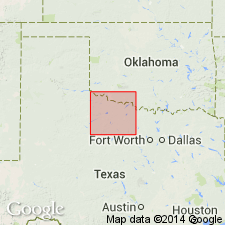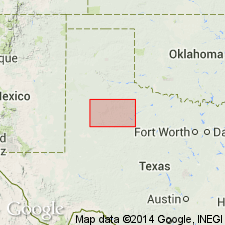
- Usage in publication:
-
- Choza formation
- Modifications:
-
- Original reference
- Dominant lithology:
-
- Shale
- Dolomite
- AAPG geologic province:
-
- Permian basin
Summary:
Map, p. 49. Choza formation. Includes rocks from top of Bullwagon dolomite to [unconformity in later reports] base of San Angelo formation. Consists of a series of red shales separated by groups of thin dolomite beds, some of which are fossiliferous. Highest dolomite in formation is Merkel dolomite, which lies 270 feet below top of formation. Thickness of formation 870 feet. [Age is Permian.]
Named from Choza Mountain, near Tennyson, Coke Co., central TX.
Source: US geologic names lexicon (USGS Bull. 896, p. 440).

- Usage in publication:
-
- Choza Formation
- Modifications:
-
- Not used
Summary:
Area of report is north-central TX, approximately between the Brazos and Red Rivers; in this area the Choza, Vale, and Arroyo Formations of Clear Fork Group of the Colorado River Valley of TX are not distinguishable. [Author maps Clear Fork Group undivided, except for "Merkel Dolomite" and "Bullwagon Dolomite", some sandstone beds, and "Lytle Limestone". Listed in descending order: Merkel is topmost member of Choza Formation, Bullwagon is topmost member of Vale Formation, and Lytle is a middle member of Arroyo Formation, all of Clear Fork Group of the Colorado River Valley.] Clear Fork Group is extensively covered by Quaternary deposits. Leonardian (Early Permian) Clear Fork Group is mapped in: Haskell and Knox Cos, Permian basin; Throckmorton and Baylor Cos, Bend arch; and Foard, Wilbarger, and Hardeman Cos, Palo Duro basin. Geologic map.
Source: GNU records (USGS DDS-6; Denver GNULEX).

- Usage in publication:
-
- Choza Formation
- Modifications:
-
- Mapped 1:250k
- Dominant lithology:
-
- Shale
- Sandstone
- Dolomite
- AAPG geologic province:
-
- Permian basin
Summary:
Is Permian formation mapped along southeastern margin of map sheet in southeast King and eastern Stonewall Cos, TX (northeastern Permian basin). Is oldest bedrock unit mapped in this sheet; overlain by San Angelo Formation (Permian). Map unit described as shale and sandstone interbedded; Merkel Dolomite [unranked; member?] separately mapped at top, feathers out northeastward. Shale, sandy in part, alternating red and bluish green. Sandstone, fine-grained quartz, calcareous in part, massive, moderately indurated, gray. Thickness 100 ft.
Source: GNU records (USGS DDS-6; Denver GNULEX).
For more information, please contact Nancy Stamm, Geologic Names Committee Secretary.
Asterisk (*) indicates published by U.S. Geological Survey authors.
"No current usage" (†) implies that a name has been abandoned or has fallen into disuse. Former usage and, if known, replacement name given in parentheses ( ).
Slash (/) indicates name conflicts with nomenclatural guidelines (CSN, 1933; ACSN, 1961, 1970; NACSN, 1983, 2005, 2021). May be explained within brackets ([ ]).

